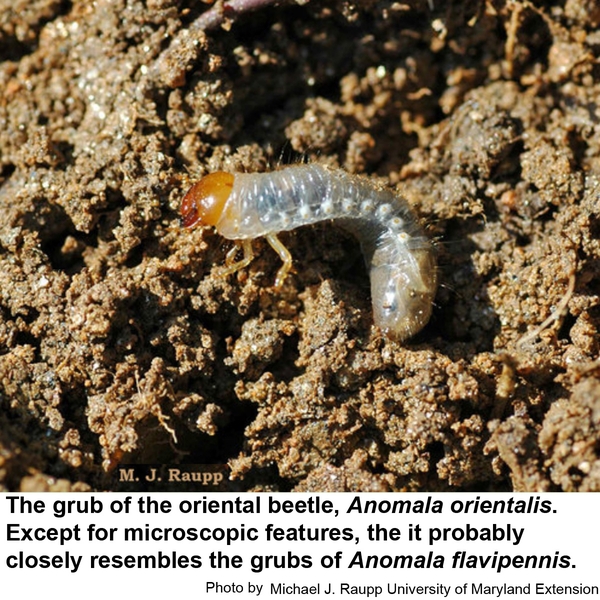Description and Biology
The Anomala flavipennis beetle is a shiny scarab with ochre-brown wing covers and a reddish brown thorax. Beetles in the genus Anomala are informally called cockchafers. In Florida this species is called the panhandle beach anomala scarab beetle. It is about the size of the Japanese beetle (half inch long), and is attracted to lights. The larvae are C-shaped grubs that feed on the roots of grasses including corn, wheat, and sorghum (in Northeastern Mexico, it is a major soil pest of corn and sorghum). In North Carolina, this species has one generation per year. The beetles emerge in the spring especially after rain. Females lay their eggs in the soil from which hatch tiny grubs. The grubs feed primarily on the roots of grasses.
Host Plants
The only references to the feeding habits of A. flavipennis include feeding on the roots of grasses, corn, sorgham, and wheat. Other scarab grubs are sometimes pests of pine seedlings and boxwoods in nurseries, and it would not be surprising if A. flavipennis did feed some on the roots of shrubs and trees especially in the fall when annual grasses are dying back. Adults in the genus Anomala are called cockchafers that feed on foliage and flowers of various plants.
Residential Recommendation
If Anomala flavipennis grubs become a nuisance in turf (more than 10 grubs per square foot), an insecticide labeled for insect control in home yards should give adequate control. Because they are atracted to lights, adults can be killed by using a light bulb suspended over a pan of soapy water at night.
References
- 2023 Pest Control for Professional Turfgrass Managers. Billeisen, T. et al. 2023. NC State Extension Publication AG-408. 81 pp.
- A Sixteen-Year Study on the Bivoltinism of Anomala flavipennis (Coleoptera: Scarabaeidae) in Mexico. Rodriguez-del-Bosque, L. A. 1998. Environ. Entomol., Vol. 27 ( 2). pp. 248-252.
- Pathogenicity of Metarhizium anisopliae and Beauveria bassiana against Phyllophaga crinita and Anomala flavipennis (Coleoptera: Scarabaeidae). Rodriguez-del-Bosque, L. A. et al. 2005. J. Entomol.l Sci. 40: 67-73.
- Modelo conceptual de coexistencia entre Phyllophaga crinita y Anomala flavipennis en agroecosistemas del Noreste de México. Rodríguez-del-Bosque, L. A. 2007. J. Agricultura Técnica en México. Vol. 33 (1) pp. 89-94.
-
Species Anomala flavipennis. Rose, J. S. 2022 (update). BugGuide. Iowa State University Dept. Plant Pathology, Entomology, and Microbiology.
- Horticultural Science Publications
- North Carolina Agricultural Chemicals Manual
For assistance with a specific problem, contact your local N.C. Cooperative Extension Center
This Factsheet has not been peer reviewed.
Publication date: Nov. 19, 2012
Revised: May 4, 2023
The use of brand names in this publication does not imply endorsement by NC State University or N.C. A&T State University of the products or services named nor discrimination against similar products or services not mentioned.
N.C. Cooperative Extension prohibits discrimination and harassment regardless of age, color, disability, family and marital status, gender identity, national origin, political beliefs, race, religion, sex (including pregnancy), sexual orientation and veteran status.


